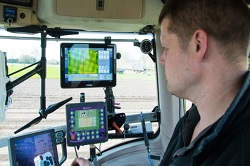Enabling precision farming across Europe through GNSS
The costs associated with agriculture are on the rise and environmental demands are gaining ground by the day – meaning efficient and sustainable farming solutions are needed more than ever. One such solution is precision agriculture. From automatic steering to farm machinery guidance, variable rate application, yield and soil monitoring and livestock tracking, all precision agriculture applications depend on the precise positioning provided by GNSS. However, in order to get the level of precision that these types of farming applications demand, GNSS signals must be augmented. In Europe, this augmentation is provided by EGNOS, Europe’s regional satellite-based augmentation system that is used to improve the performance of GNSS. The problem is that agriculture is a rural endeavour, meaning some farms are located in areas where EGNOS coverage is poor. To help improve the performance of EGNOS, the EU-funded AUDITOR project is developing a ground-based GNSS augmentation system that will deliver high-performance and cost-efficient services and applications for the agriculture industry. ‘The purpose of this project is to develop an improved GNSS ground-based augmentation system using modern and proven algorithms in highly configurable, cost-effect receivers,’ says Project Coordinator Esther Lopez. ‘As a result, AUDITOR will enable cost-effective precision agriculture services to farmers, especially for those with small and mid-sized farms in areas where EGNOS availability is limited.’ The AUDITOR architecture AUDITOR’s architecture is based on a RF dual-band multi-constellation GNSS front-end and an embedded digital processing platform. The front-end receiver acquires the GNSS signals and embeds all analogue and digital hardware required to convert the RF signal to digital samples. The digital processing platform then converts and customises the signals for the AUDITOR systems. The system then serves as the basis for providing higher-level services for the end user via cloud-based web and/or mobile applications. The future of farming AUDITOR is set to enable a range of precision agriculture applications. For example, with AUDITOR applications, farmers can accurately measure spatial variability in soils and crops. This information, expressed in the form of yield maps, allows the farmer to precisely apply fertiliser, water and pesticides – thus reducing production costs and the farm’s environmental impact. The high-accuracy positioning it provides also enables the use of autonomous mobile robotic units, used for identifying weeds, pests and diseases. ‘The making of soil and crop maps, as well as the spatially varying application of fertiliser that these maps enable, is completely dependent on the availability of a high-quality GNSS signal,’ says Lopez. ‘Now, thanks to AUDITOR, even areas in Eastern and Southern Europe that once were unable to get this required GNSS signal can reap the benefits of precision agriculture.’ With the ever-increasing requirement for augmented yield and profitability and energy and cost savings, the future of farming is precision agriculture. By focusing on providing the augmentation needed to enable existing precision agriculture applications in Europe alone, Lopez is confident that AUDITOR is well-positioned to compete on a market with an estimated EUR 180 million value.
Keywords
AUDITOR, agriculture, GNSS, precision agriculture, satnav, EGNOS, farming

